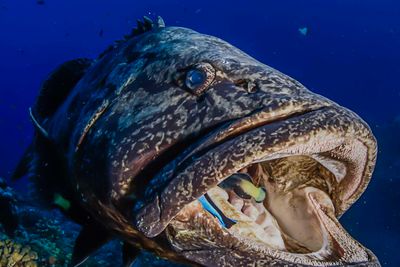It’s fair to say that there has been some confusion
surrounding the loosening of the lockdown. We’re confident that the
Great British public will use their famed common sense to work
things out – after all, this is the nation that elevated queuing to
an art form – but in the meantime, we’ve turned to a few of our
favourite marine species for inspiration on how to socially
distance, and compared them to some species whose behaviour leaves
a lot to be desired. In short, be more sole than shoal.

Great Hammerhead Sharks vs Scalloped Hammerheads
Great hammerheads are a solitary species and
migrate long distances (upwards of 800 miles) alone. There are a
few spots they can be seen around the world, with one of the very
best being Bimini
in the Bahamas, in just 8m of crystal clear waters, meaning you can
enjoy the experience of seeing these monsters (which can reach as
long as 20ft) for longer.
Scalloped hammerheads, on the other hand, can
congregate in very large schools of hundreds or more adults.
Scientists are still unsure exactly why they do this at certain
times of the year (they do ‘socially distance’ at other times), but
if you are lucky enough to witness one of these schools, it is a
truly magical experience. Our favourite places to see schooling
scalloped hammerheads include the
Galapagos,
Socorro (Mexico) and
Cocos Island (Costa Rica).

Oceanic Manta Rays vs Mobulas (Devil Rays)
Stat attack: The oceanic manta ray is the
largest ray and one of the largest fish in the world. Reaching
widths of up to 29 ft, manta rays are much larger than any other
ray species and are typically solitary animals, although they do
congregate to feed and – obviously – to mate.
Closely related to mantas, mobula rays are an
open water species that feed on plankton and other micro-organisms.
They have been known to form huge schools – sometimes exceeding
10,000 (not a typo) individuals. See these schools off the coast of
Mexico
in Southern Baja California (between mid November and January)
and in the Sea of Cortez (between mid April and early July).
Mobulas are famous for their ‘aquabatic’ feats and can regularly be
seen leaping from the water.

Blue Whales vs Bottlenose Dolphins
The blue whale is the largest animal ever to
have lived, with a maximum recorded weight of 190 tonnes. Apart
from females with their young, blue whales are solitary animals
that only occasionally gather in groups to feed. They are found in
both polar and tropical water worldwide, migrating between the two
at different times of year. It is possible to see them off the
coast of Sri Lanka between November and April.
At the other end of the cetacean scale, bottlenose
dolphins are very social animals, and often travel in
groups called pods. The most common is a nursery group of between
five and 20 dolphins made up of females and their calves, although
occasionally they will gather in groups (with males) of 1,000 or
more. They often hunt together and learn different tricks for
catching food from one another (such as using sponges to dig up
buried prey) in a fascinating example of cultural transmission. Our
favourite spot to see bottlenoses also happens to be one of the
best dive sites in the world: the Tiputa Pass in
Rangiroa, French Polynesia. A resident pod of around 20
regularly comes to visit divers, with three individuals famous for
being particularly interactive.

Potato Cod vs Barracuda
The potato cod is identified by the large,
potato-shaped blotches on its body, and is mainly found in tropical
waters. It is generally a solitary species and can be found on
coral reefs from depths of five to 150 metres. They are also bold
and inquisitive, and grow to a maximum length of seven foot and a
maximum weight of 220 pounds. The best-known location to see them
is the aptly named Cod Hole, located off Lizard Island in the
northern part of Australia’s
Great Barrier Reef.
The barracuda is a large type of predatory fish
found in the warmer, coastal regions of the world’s oceans. There
are more than 20 different species, ranging in size from less than
two feet to nearly seven feet in length. While they are considered
to be solitary while hunting, young barracudas tend to gather in
large schools, sometimes in hundreds or even thousands, which
offers the young fish protection from predators on the basis of
safety in numbers. Barracudas can be seen in many different
locations, but one of our favourites is Bradford Shoals seamount in
Kimbe Bay,
Papua New Guinea, where there is a resident school of around
1,000 barracudas that form the most spectacular torpedo-like school
in 40m visibility.

Peacock Mantis Shrimp vs Pistol Shrimp & Goby Fish
Peacock mantis shrimps might as well be called
anti-social shrimps. They are famous for their attacking ‘punch’ –
the strongest in the animal kingdom relative to the creature’s
weight – which disables prey and acts as a pretty potent social
distancing measure. They can be highly territorial and have
developed complex social behaviour to defend their space from
rivals without the risk of punching or being punched.
Meanwhile, pistol shrimps are inveterate
burrowers and are constantly maintaining and creating new burrows
in coral reefs and mangroves. They enjoy a symbiotic relationship
with the goby fish that share their burrows in a
phenomenon known as ‘mutualism’. Pistol shrimps have very poor
eyesight and so aren’t able to see predators until it’s too late,
so the goby fish stands guard outside the burrow watching for
potential threats while the shrimp continues to dig. Because of
their poor eyesight, the shrimps touch the gobies with their
antennae to communicate. This pair can be found across the
Indo-Pacific region.

 Private Scuba Tuition – Learn Scuba Skills.
Private Scuba Tuition – Learn Scuba Skills.
Leave a Reply
Want to join the discussion?Feel free to contribute!